Abstract
The main aim of this study is to investigate Human Resource Management of the Hong Kong Rugby Sevens with respect to personal training, logistical support, manpower rearrangement, crowd security, sanitation and catering services. The study has explored a wide variety of literature which focuses on personnel management in major sporting events. One of the literatures points out that the core competencies required in the management of major sporting events include managerial capacity, multitasking skills, leadership skills, time and stress management and detail orientation. Another one stresses that the interest of all stakeholders must be considered in the 3P stages, namely preparation, process and post-event evaluation. By taking these two literatures into consideration, it is evident that Human Resource Management is critical to the success of sporting events. This study, therefore, relies on the literature and case study analysis in order to draw inferences. Data was collected through interviews and interpreted.
Introduction
Overview
This chapter covers the background to the study, problem statement, research objectives, hypotheses and the significance of the study.
Background to the study
The Hong Kong Rugby Sevens is one of the leading sporting events on the HSBC IRB Series. The Hong Kong Rugby Sevens is the 6th competition out of the nine tournaments in the HSBC IRB Series. The tournament is held every year. The tournament is organized by the city’s rugby union, which also oversees the local rugby tournaments (Signes 1). The great success of the Hong Kong Sevens is always felt all over the globe. The international media and individuals from all countries often acclaim the astonishing opening and closing ceremonies, lovely design of the stadium, well-run institution, and splendid exhibitions of the global competitors. Be that as it may, there has been exceptionally constrained writing about the personnel management in major sporting events such as the Hong Kong Rugby Sevens and the Olympics. This paper will attempt to answer to these queries (Signes 2).
Human resource management in major sporting events is a daunting task (Hanlon and Stewart 80). The shift in population is transforming the nature of a psychological contract, such that employees are becoming more aware and are able to choose organizations based on subjects such as policy diversity, life balance, and the degree of freedom. Besides, highly talented individuals are the less malleable resource for an organization and are mobile investors in terms of intellectual, social and emotional capital (Hanlon and Stewart 81). Therefore, bringing together a highly competent event management team requires a high level of preparation and planning (Berger and Berger 12). Additionally, during the Hong Kong Rugby Seven tournament, more than 300 temporary employees and volunteers are hired and, therefore, the interest of all the stakeholders must be considered (Signes 2).
Problem Statement
HRM studies in general have been criticized (Phillips 14; Lawler and Susan 18). According to Henlon and Stwart, HR studies are confusing and most of them are highly flawed. She states that most of the HR authors always force a positive correlation between HR practices and organizational results (84). Berger and Berger point out that for almost a century no common HRM approach has been identified to meet the present and upcoming needs in terms of locating, appraising and developing talent. As a result of this, Talent Management has been conjured up. Another problem with HR studies is that different countries have different laws and labour practices and, therefore, it is hard to generalize results (15).
With personnel management in a major sporting event being such a multifaceted and pondered subject, a number of questions have come up. For instance, how are human resources deployed in the preparation of major sporting events with respect to personal training, logistical support, manpower rearrangement, crowd security, sanitation and catering services? Since studies on human resource management in major sporting events are scarce, this study will attempt to answer these questions.
Research objectives
The main objective of the study was to analyse human resource management of Hong Kong Rugby Seven 2014 in the 3P stages, namely preparation, process and post-event evaluation. In line with this, the specific objectives were:
- To establish how human resources were deployed in preparing the Hong Kong Rugby Seven 2014, with respect to personnel training, personnel deployment and logistical support.
- To examine how human resources were deployed during the implementation of the Hong Kong Rugby Seven 2014, with respect to manpower rearrangement, security check, sanitation and catering services.
- To evaluate how human resources were deployed after the implementation of the Hong Kong Rugby Seven 2014, with respect to evaluation on the personnel training, personnel deployment, logistical support, manpower rearrangement, security check, sanitation and catering services.
Research hypotheses
In line with the main objective, the following hypotheses were tested:
- Proper deployment of human resources was beneficial in the preparation of Hong Kong Rugby Sevens 2014.
- There is a correlation between HRM and the personnel training, personnel deployment, logistical support, manpower rearrangement, security check, sanitation and catering services.
- Crowd security and catering services were given a lot of focus due to their impact on the tournament’s success.
Justification of the study
This study is vital because of the way that it adds to the accessible collection of learning with respect to human resource management in major sporting events. The consequences of this study are extremely applicable to the management of personnel in the 3P stages, namely preparation, process and post-event evaluation.
Literature Review
Introduction
Human resource (HR) is defined as an individual contribution to an organization or institution in terms of efforts, skills and capabilities. On the other hand, human resource management (HRM) is the division that deals with the management of human resource (Dessler 4). Human resource management can be viewed in two perspectives. First, human resource management is the personnel or support function. Secondly, HRM is a top management function. Whether in the formal or informal sector, the management of employees is always a function of the top management (Sokun 3).
Initially, human resource management (personnel management), was regarded as an administrative subject. In addition, HR measurements were based on the turnover rate, non-attendance and parallel measurements (Dessler 4). At the moment, Human resource management in its most basic form emphasizes on building competitive advantage through the strategic use of contemporary HRM techniques to develop competent personnel. This characterization aims to sum up the view of the present organizations subscribing to the idea of employees being the most significant asset (Sokun 5).
The management and staffing are carried out by individuals and without them organizations cannot exist. As a matter of fact, the prospects and challenges of developing and managing an organization are normally caused by individual-related problems. On the other hand, individual-related problems often emerge from the misconception that all people are equal and deserve equal treatment. However, this is far from the truth. Each and every individual is unique both physically and psychologically and should be treated differently (Dessler 5).
Human Resource Systems
In order to acquire the right personnel at the right time, human resources systems, for instance, human resource planning, recruitment and selection have to be engaged. Human resource planning is a process of developing strategies to organize the elements and skills of the personnel as per the needs. Human resource planning helps to predict, hire, preserve and optimize recruitment of candidates that meet the needs and goals. On the other hand, recruitment refers to the process of identifying potential candidates and persuading them to apply for the current or foreseeable position. During the recruitment process, attempts are made to notify the candidates about the job requirements, qualifications and available opportunities. Last but not least, selection is the process of picking qualified and competent candidates from a pool of new applicants (York 12).
According to York, organizations can consciously and practically determine the composition of the personnel needed to realize strategic goals by ensuring that the recruitment and selection practices match with the existing policies and programs (14). The first step in identifying key individuals lies in the ability to determine the profiles that match with the existing culture and needs. This enables the HR division to equate candidates’ background, job experience and individual qualities to develop an excellent fit. In addition, it is improbable that all key individuals would come from within or are out of work (Backhous and Surinder 501).
According to Dessler, search for external talents should not only focus on well-established professionals, but also on upcoming talents (22). Moreover, support is needed when attracting new talent from a competitive market. This point is supported by York who witnessed institutions struggle to keep hold of their key talents during the global economic crisis. This was particularly common in the United States (79).
The recruitment process is very expensive. Therefore, it is very important for the HR department to keep hold of their key employees for a long period of time. One of the failures related to the recruitment process is recruitment based on qualifications, which is regarded by York as a poor performance predictor (78). According to York, a better recipe for successful recruitment and selection is hiring based on competencies, which is a fundamental aspect of Talent Management (79). Dessler explains that it is easier to hire a squirrel to climb a tree than teach a turkey (107). He used this phrase to describe competence-based recruitment and selection practices. In other words, the recruitment and selection process should be based on individual traits and characteristics that are hard to be taught or changed.
Individuals with the right competency can effortlessly perform certain tasks and are easy to train. Competency is a principal characteristic of a person and is fundamentally linked to effective or excellent performance at work. Therefore, competency is any individual characteristic that is assessable and can be used to differentiate a poor performer and greater performer. Dessler identified the core competencies recognized by most organizations globally, which include: the capability of an individual to acclimatize promptly to external and internal changes; the ability to successfully influence and work through others; the ability to change mindsets and behaviours; leadership abilities; and the capacity to work with others (108). Lawler and Susan present other examples of competencies, which include objectivity, traits, personality concepts, content knowledge, and cognitive and behavioural skills (23). In a nutshell, human resource systems in an organization should not only focus on academic qualifications, but also competencies.
Some experts have criticized performance measurement as lacking connection to strategy, hence giving too much on internal processes (Phillips 14). Phillips commented on the development of talent and noted that it is becoming a more strategic decision when examining the cost to be incurred in training and development. He further argues that the most useful talent should be allocated the largest share in the training budget. In addition, he recognizes the insignificance of these statements if the company has no means of gauging their workers and suggests a scorecard approach (16).
The scorecard approach offers both, qualitative and quantitative measurements of contribution and supply very important information (Phillips 22). Scorecards can take different shapes and forms, yet they have attracted a wide range of users across the board. This is because they allow for an immediate evaluation of key measures and the appraisal of individual status in an organization. Thus, scorecard has become a significant component in shaping the direction of the HR investment, performance enhancement or making use of prevention programs to sustain good results (Phillips 25).
According to Berger and Berger, the employee’s scorecard has three aspects leading to workers’ success; the attitude and culture, the abilities and the leadership and workers’ behaviour. The success statement, in this case, is based on the three elements and is directly correlated to the implementation of the organization’s strategy and employee’s skills and efforts (10). The important point is identifying the measures that actually drive the strategy, which also results in better understanding of the principle components of the most crucial positions in the organization (Berger and Berger 12).
Burns also calls for a democratic style of leadership, especially when team building is required in the organization (46). When the staff members are needed in decision-making process, this kind of leadership is relevant. This kind of leadership style makes it possible for easy problem solving and objective decision-making in the organization. The structuring of this kind of leadership style is easier and cheap, even though certain organizations fear to adopt this style because when a simple mistake is made, it can take a long time to restore the organization back to normal. For this kind of leadership style to be stable, the leader should provide adequate time for the subjects to contribute to the major decision-making processes. All their (subjects) views and observations need to be taken to consideration before a judgment is passed (Burns 47).
Lovell highlights the significance of differentiating job positions and human capital and terms it as one of the significant characteristics in workforce management. This is the same as workers segmentation of talent fronted by Berger and Berger. Organizations can use position “A” to refer to the right position in terms of employees’ performance and should encourage all its workers to aim at this position. However, one of the difficulties in the implementation of talent management is the evaluation and differentiation that cause conflicts among workers, especially in a social democratic and liberal environment (56).
Human Resource Management in Major Sporting Events
When reassessing studies on event management, Hede utilized stakeholder theory to explain the significance of stakeholders’ interest during the organization and planning phase (14). Hede highlighted the core competencies required in the management of major sporting events, which include managerial capacity, multitasking skills, leadership skills, time and stress management and detail orientation among others. Henlon and Stwart are renowned for their studies on human resource management in major sporting events, including the Olympic Games and Rugby Sevens. They explained the intricacies and principles of personnel management in major sporting events (79).
Henlon and Stwart describe the significance of national cultures in global sporting events. The national cultures help in creating an exceptional communication and work style environment. For instance, cultural minorities (foreign national with unique skills) will find it difficult to manage cultural majorities (locals) if they lack adaptation skills, social skills, inter-cultural communication skills, widespread knowledge of the host nation, excellent attitude, global management skills and dedication (78). In addition, the people in charge of personnel management in global sporting events must have a lucid strategic goal, chose partners with matching or corresponding competencies, have a clear-cut governance structure, consult and build consensus, appreciate cultural diversity and persistently monitor the host nation’s economic environment (Henlon and Stwart 79).
Zhao points out that associates in a joint venture should come up with a strategic objective that would enable them pool their competencies together. He also explains the importance of strategic framework for any form of alliance (7). From the strategic management point of view, personnel management in major sporting events can be examined through an input-transformation-output model. In this model, personnel, materials, facilities and operations are regarded as inputs, whereas the management functions or sub-functions are considered as transformation. Finally, employees and clients fulfilment, as well as fiscal accountability are regarded as output. According to this model, the success of any sporting event is pegged on workers motivation (Zhao 8).
According to Henlon and Stewart, a mixture of nonfinancial and financial measures is vital in enhancing employee motivation. He argues that employees play a very critical role in accomplishing the set objectives. In addition, teamwork among the employees has a major brunt on the success of major sporting events. Further, organizational culture with particular to employees will have a lasting brunt on the overall performance (80). Glannoulakis, Wang and Gray added that major sporting events require highly motivated and hard working personnel, as well as smooth and standardized logistical operations (192).
Motivation could also include compensation and benefits. Compensations refer to all kinds of economic returns and substantial benefits that workers receive as a part of their pay. Compensation can be categorized into two, namely: cash compensation and fringe compensation. Cash compensation is the direct payment received by employees for their labour. On the other hand, fringe compensation refers to all other benefits. Fringe benefits can be legal or discretional. Legal fringe benefits include social security and employee compensation, whereas discretional fringe benefits include health benefits, retirement funds, promotion and other increments. Therefore, the benefits can either be financial or nonfinancial. Compensation and benefits play a major role in the recruitment and retention of employees (Lovell 89).
However, the major subject of debate in the recent past has been whether compensation and benefits can enhance job satisfaction. Job satisfaction is defined as “the pleasurable emotional state resulting from the evaluation of one’s job as achieving or facilitating one’s values”. At the same time, job dissatisfaction is defined as “the unpleasant emotional state resulting from the appraisal of one’s job as frustrating or blocking the attainment of one’s values”. The two-factor theory posits that employees have two fundamental types of needs, that is, motivation and hygiene. Hygiene factors are those necessities that can be fulfilled by particular conditions, for instance, regulations, interpersonal relations, working conditions and remunerations among others. The theory suggests that job dissatisfaction normally arises in cases where hygienic factors do not exist. For this reason, financial benefits alone are not enough to keep hold of key talents. The general welfare of the employees and improvement of the working environment is also necessary for the recruitment and retention process (Lovell 92).
Since major sporting events are characterized by a strong culture and tradition, they demand outstanding leadership qualities (Chamoun, Habicht and Bernauer 22). Most of the current event managers base their leadership on classical management style, which focuses on planning, managing, and assessing. The outcome of this style of management is absolute adherence to laws and regulations with modest room for personal liberty, inventiveness and novelty (Al-Ababneh 96). Chamoun, Habicht and Bernauer recommend transformational leadership that makes efficient use of human resources. A transformational is able to develop a strong vision, which helps in clarifying and communicating organizational goals (22). In addition, transformational leadership creates an environment that cultivates enthusiasm, loyalty and steady improvement. Nonetheless, besides Chamoun, Habicht and Bernauer no other sports and event management literature reveals any aspect of transformational leadership. Most of them emphasizes on strong leadership that incorporates transformational aspects.
Organizing a major sporting event can be an overwhelming task. Whereas the scale of the events differs considerably, the code of event management is basically identical (Tasmia 1). Zhao put on the significance of the organizing committee and event manager during the planning and preparation stage. A committee with clearly defined roles and responsibilities is essential. This is because usually more than one individual is involved in organizing major sporting events. The committee must appoint an event manager who is in charge of key decisions and directions. The support of local stakeholders, including volunteers is also crucial (Zhao 13).
In accordance with Chelladurai, representation in major sporting events is on a voluntary basis. The organization is normally progressively organized with a basic reporting line. However, most event organizations lack an expressed human resource policy framework, which means that planning is not given adequate attention. In addition, the focus is always on yearly projects and exercises, therefore, long haul HRM needs are not taken seriously (8).
Hanlon and Stewart explain that the sports industry’s uniqueness is characterized by the incomparability of games and its capacity to induce perverse interests and enthusiastic connections, regardless of the typically variable nature of the product (80). Sport’s distinctiveness is additionally epitomized by elements of insubstantiality, diversity and indivisibility of generation and use. All these create an exceptional management environment for the event organizers. For this reason, effectual management of personnel who are employed or volunteering is very crucial. Furthermore, the management of major sporting events has really changed as a result of expanded globalization, commercialization and increased demand for accountability (Hanlon and Stewart 82).
The roles traditionally held by volunteers have been taken by salaried workers. The recruitment and selection of these workers are based on their technical and professional abilities. On the other hand, the committee members are appointed based on their business acumen and not just their knowledge in sports (Chelladurai 17). A lot of focus is placed on attracting, developing and retaining key talents. One of the most outstanding reasons for retaining key talents is to save costs, for instance, costs of training and developing new recruits. Therefore, most sports organizations often strive to retain the internally available talents as a strategy of cost cutting (Robinson 44).
Most studies on personnel management in major sporting events have shown that employee retention is connected to their personal developments. Even though there are differences with regard to the cultures of sports organizations, monetary returns are not perceived to be in line with the employee retention strategies (Hanlon and Stewart 83). A number of organizations have resorted to job rotation to hold on to their key HR resources. Job rotation enhances the mobility of skills across the various departments within the organization. In order to enhance job rotation, more lucrative jobs are created horizontally so that employees won’t have to compete for the scarce vertical positions (Berger & Berger 32).
Locals are normally given first priority during the recruitment process. This is partly because of their familiarity with the area and government policy that gives the first right of employment to the citizens. The labour laws limit the number of expatriates that can be hired. Besides, the event organizers always want the locals to feel like they are part of the tournament (Hanlon and Stewart 86). Selection involves both the applicants and the company and, therefore, it is a dual process. The organization makes sure that candidates have full information in order to make an informed career decision. The organizers normally achieve this by arranging informal and formal meetings and interviews between the existing staff and the applicants. Normally, the organizers select candidates through the following stages. The first stage entails a review of the application form. They look for a balance between the excellent academic qualifications and evidence of the above-mentioned skills and expected behaviour (Robinson 46).
The second stage involves language test. Language is a fundamental requirement. The third stage involves visiting an assessment centre. The aim of these centres is to evaluate the applicants’ aptness for a given position by assessing them based on various proficiencies pertinent to the work environment. An assessment centre provides candidates with an opportunity to demonstrate their skills practically. The fourth stage entails an interview with the management and venue tour. The candidates also have an opportunity to meet staff members and volunteers (Robinson 46).
Subsequently, the candidates that have passed this stage proceed to another interview. This objective of this interview is to establish the candidates’ potential for the job sought. Some of the qualities evaluated here include teamwork, management, zeal, communication and presentation. This is because the event organizers require more than just technical skills (Robinson 46). The next stage is the last interview. The last interview gives the organization an opportunity to clarify any pending matters. Similarly, it provides the candidate with an opportunity to raise any outstanding issues. Finally, the sixth and the last stage is employment offer. An employment offer is only issued to successful candidates (Robinson 47).
Methodology
Introduction
The methodology is the process of instructing the ways to do the research. It is, therefore, convenient for conducting the research and for analysing the research questions (Blanchard and Cathy 56). The purpose of this research was to create a room for further research that will assess the human resources management of the Hong Kong Rugby Seven 2014. Exploratory research study provides researchers with an opportunity to assess areas that do not have extensive research (Saunders, Thornhill and Lewis 78). Therefore, engaging in exploratory study contributes to the development of additional knowledge on the issue or phenomenon under investigation. This goal comes by testing the stipulated hypotheses. To undertake the research study, a comprehensive research methodology is necessary. This part includes the research design, the sample and the methods used in gathering information. It also contains the data analysis methods, validity and reliability of data and the limitation of the study.
Quantitative and Qualitative Approach
Quantitative research approach refers to the use of statistical techniques, mathematical methods and calculation techniques to analyse data (Saunders, Thornhill, and Lewis 80). The quantitative methodology aims at utilizing mathematical and statistical theories and models to analyse the data. The quantitative method validates the hypotheses and conclusions that stem from the qualitative methodology. The scientific procedures and processes that help in quantitative methodology encompass deriving models and theories; designing instruments for data gathering; controlling the variables empirically; and analysing data using models. Qualitative approach strictly generates only information that applies to the designated case study; any additional information is guessed. Once the hypotheses stem from a qualitative approach, they filter through the quantitative approach.
Research Design
The study utilized the exploratory research design. The exploratory research design mainly explores the nature of the problem in order to draw inferences. Exploratory research is mostly applicable in circumstances where the structure of the research problem is not definite. The interview is a good example of the methods that helps to gather information in this kind of research. Considering the exploratory nature of the research study, the research adopted a mixed research design. The study took into account the qualitative and quantitative research designs. The choice of the mixed research design arose from the need to improve the quality of the research study.
Case Study Approach
A case study is an approach of methodology that applies when a comprehensive research or investigation is required. The case study is widely applied in sociological studies, but of late, it applies in research institutions. Case study approach has procedures to follow; hence, the researcher is required to stick to the guiding rules and principles to produce the best results. Through a case study approach, the researcher has access to a wide range of data sources; because of this, case study results are always very comprehensive and in-depth.
The case study research does not entail sampling; hence, it is beneficial to select the cases in a relevant manner in order to maximize on what is valid. Through a case study approach, relevant issues that form the basis of the study reveal. In addition, issues that appear to be more complex come out using the case study as a research approach. The basic steps to follow when structuring a case study approach are the research questions should be clearly stated and defined, choose the cases and the data collection and analysis techniques, arrange to gather data, process and analyse the collected data, and make a report with regard to the analysed data.
Population and Sampling
There are two popularly used procedures for sampling. The sampling procedures include prospect sampling and non-prospect sampling (Blanchard and Cathy 56). In a probability sampling procedure, the samples are representative of the population. This is because all the entries have a chance of selection. On the other hand, items in the non-probability sampling do not have an equal chance. In this scenario, not all the items in the population have equal chances of selection. The data for the study came from the employees of the organization under study. The employees had profiles that fit the context of this study. Therefore, the employees were an excellent choice because many of them have had the organization experience. Because not all the employees could be accessible, a non-probability sampling procedure was important in this study.
A pilot test needed to ensure that the questionnaires were reliable and valid. After the pre-test, the questionnaire editing was important to remove and change some words. Another pre-test was then important to be sure that the questionnaire was now very reliable and very valid. Conducting a study on the entire population is not manageable due to the high cost and the amount of time required. Consequently, the research study will take into account the sampling technique. To make the study manageable scholars found that the research will integrate the simple random sampling technique in constructing the research sample (Scott 90).This technique will ensure that there is no bias in conducting the study. The study had a sample of 203 respondents for data collection. The study will take into account both males and females in constructing the research sample. The study assumes that the selected research sample will be representative of the workforce perception of the relationship between pay and performance. The choice of these regions has arisen from the need to understand the impact of social and cultural diversity on the employee perception and hence performance.
Data Collection and Instrumentation
In any research, there are basic stages that are involved in regards to the shaping of the research. These stages include understanding the research problem, the conceptual framework of the research, data collection, data analysis and interpretations, and drawing inferences and making recommendations. In this study, quantitative research method helps to test the hypotheses formulated. The adoption of primary sources played a fundamental role in improving the relevance of the research findings. The integrated interviewing technique helped to collect data from the field. Consequently, a set of questionnaires was developed. The questionnaires acted as a guide in conducting the interview. The questionnaires were mainly composed of open-ended questionnaires to provide the respondents with an opportunity to answer the required issues based on their opinion.
Questionnaire Survey
Questionnaires are a pre-formulated set of questions that require the respondents to record their answers usually within closely defined alternatives. The respondents can receive the questionnaires from the researcher via mail or through personal delivery. Before designing a questionnaire, there are three principles to pay attention to, these principles include principles of wording, principles of measurement, and the general set-up of the questionnaire. The principle of text entails the content and purpose of the questions, for instance, the researcher needs to understand the nature of variables to consider. If a variable is subjective such as satisfaction where it measures a respondent’s beliefs, perceptions, and attitudes, the questions should draw the dimensions and elements of the concepts. In addition, when tapping the objective variables such as age and income, a single direct question would be appropriate. The wording and language are other elements of the principle of text, for instance, the language of the questionnaire should approximate the level of understanding of respondents.
The principle of measurement encompasses the principles to ensure that the data collected are appropriate to test the hypotheses. These principles include categorization, which entails the adjustment of negative questions to become positive issues, coding, using scales and scaling techniques, and reliability and validity. Reliability indicates how stable and consistent the instrument taps the variable. The general set-up of the questionnaire encompasses the introduction to respondents, the length of the questionnaire, instructions for completion and the overall appearance of the questionnaire.
Data Analysis and Presentation
The collected data will be analysed quantitatively. This goal comes by incorporating quantitative data analysis tools such as tabulation, use of graphs, percentages, and charts. Considering the fact that the research study has integrated the qualitative research design, the data analysis and presentation method will entail the adoption of the textual presentation technique. This technique comes about by using statements that comprise numerals. One of the textual presentation tools that are important in analysing the research data entails the Likert scale. By using this tool, the research will be in a position to evaluate the qualitative data using point scales such as the 5-point Likert scale. In addition to the above technique, the research will integrate the Microsoft Excel data analysis technique. The adoption of this technology played a fundamental role in improving the effectiveness and efficiency with which the collected data will be analysed using tables, charts, and graphs. Moreover, incorporation of the Microsoft technique played a fundamental role in improving the ease with which the research data translates.
Limitations of the study
There has been a considerable measure of concerns on extra-budgetary costs of gathering information, paying little mind to whether the accumulated information is truly genuine or not and whether there may be an unequivocal conclusion when translating and breaking down the information. What’s more, a few representatives were hesitant to offer some data that was private and perilous in the hands of their rivals.
Findings, Data Analysis and Interpretation
Introduction
This section covers the analysis of the data, presentation and interpretation. The results were analysed using SPPS, ANOVA, regression and correlation analysis.
Sample characteristics
The data for the study came from the concerned staff of three different positions, including Manager of Cleansing Operation, Chief Manager of Security Department and General Registry Officer (Manpower rearrangement). These three individuals were chosen because they are the core staff implementing the Hong Kong Rugby Seven 2014. They were involved in the 3P stages, namely: preparation, process and evaluation of the event. The study assumes that the selected research sample will be representative of the workforce perception of the various HRM elements.
Frequency analysis
Personnel manpower
Table 4.7: Personnel manpower frequency analysis
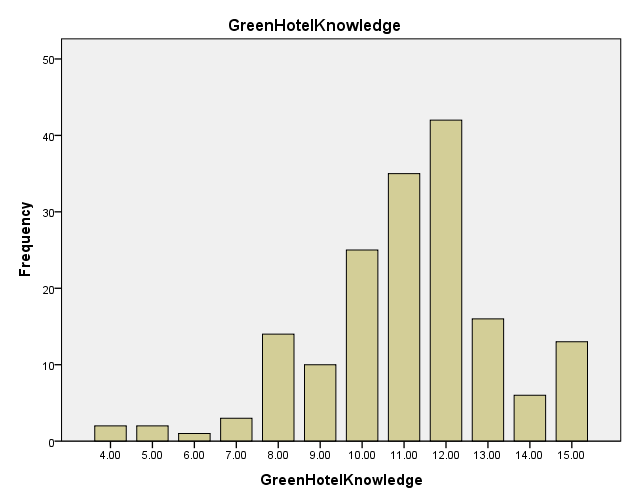
As can be seen from Table 4.7 and Figure 4.7, more than half of the participants are familiar with the personnel manpower. There are 52.1% of the participants indicate, “I am familiar with the personnel manpower policies” and 46.2% of the participants indicate, “I am familiar with the personnel manpower activities”. From the total score of these three items measuring Personnel manpower, a large group of participants have a score of 11 or 12.
Personnel deployment frequency analysis
Table 4.8: Personnel deployment frequency analysis
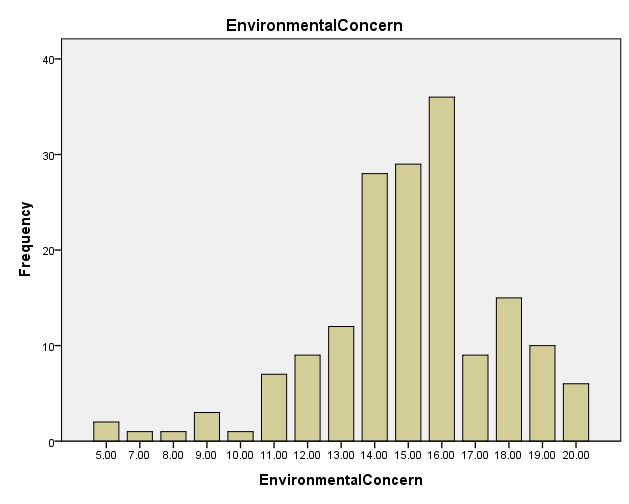
Table 4.8 shows the overall responses to the personnel deployment among participants. According to the results, the mean value of all measurement items was between three and four. Thus, the participants’ attitude, concern was at a medium level. By analysing the frequency, more than half of the participants have expressed their concern regarding the role of the human resources management of the Hong Kong Rugby Seven 2014. In order to gain a more detailed picture of the level of personnel deployment, the aggregate mean score was classified into three levels: low (below 2), medium (2-4), and high (4-5). The aggregate mean score was 3.76, suggesting a standard level of personnel deployment.
Logistical support frequency analysis
Table 4.9: Logistical support frequency analysis

Table 4.9 summarized the frequency analysis for items measuring logistical support. According to the results, the majority of the participants agree or strongly agree that “proper logistical support produces good implementation results”, “Logistical support enables the process to be undertaken within a shorter period”, and “Logistical support improves efficiency and accountability”. The aggregated mean value of logistical support is 3.98, nearly 4, suggesting that participants have a positive attitude towards the logistical support of the services. Figure 4.9 summarized the score of the items measuring logistical support.
Manpower rearrangement frequency analysis
Table 4.10: Manpower rearrangement frequency analysis
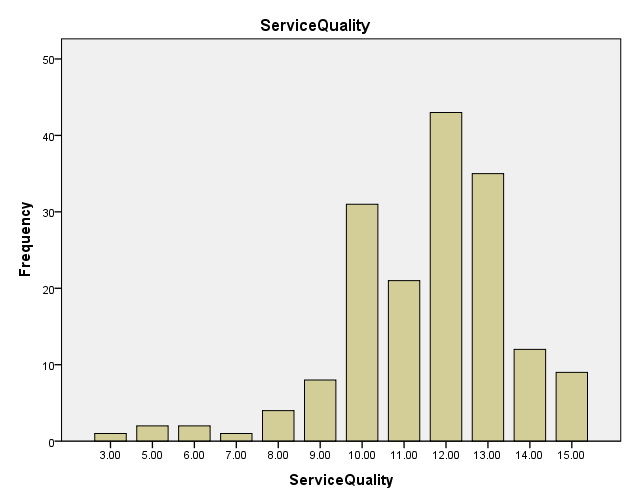
Table 4.10 summarized the frequency analysis for items measuring manpower rearrangement. According to the results, more than half of the participants agree or strongly agree, “Manpower improves awareness on services”. In addition, many agreed, “Manpower provides necessary skills for the implementation of services”, and “Manpower has a positive impact on the success of the tournament”. The aggregated mean value of logistical support is 3.85, suggesting that manpower rearrangement is at medium to high level. Figure 4.10 summarized the score of the items measuring manpower rearrangement.
Security check frequency analysis
Table 4.11: Security check frequency analysis
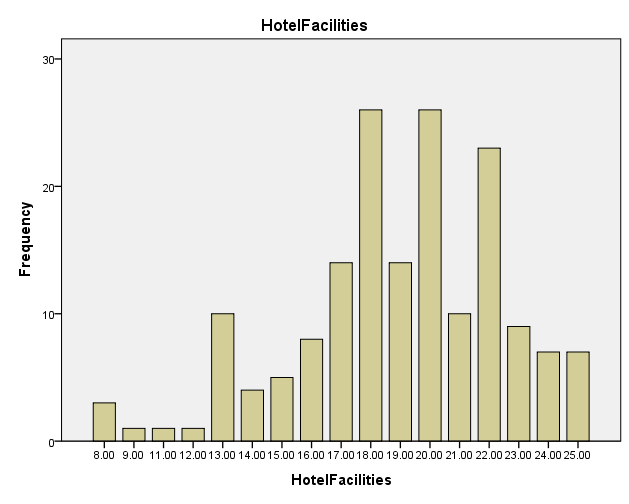
Table 4.11 summarized the frequency analysis for items measuring security check. According to the results, more than half of the participants agree or strongly agree that “The security facilities and support provided was appropriate for the tournament”. In addition, they agree, “The security check and support have a positive impact on the tournament’s success” and “Efficient security check are relevant to the success of sub-criteria of services”. The aggregated mean value of logistical support is 3.79, suggesting that the security check is at intermediate to high level. Figure 4.11 summarized the score of the items measuring organization facility.
Sanitation and catering services frequency analysis
Table 4.12: Sanitation and catering services frequency analysis
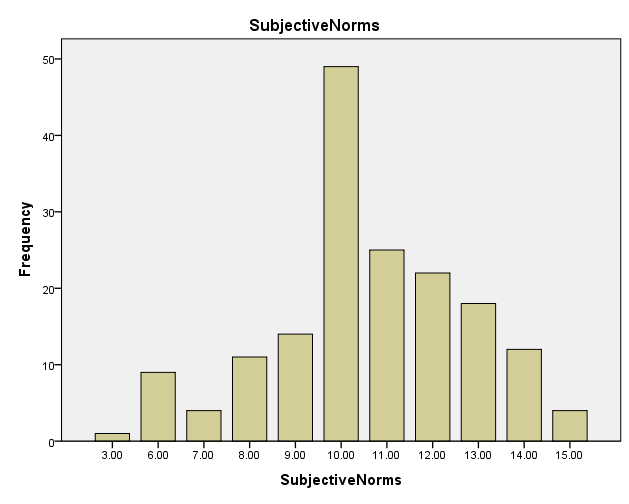
Table 4.12 summarized the frequency analysis for items measuring sanitation and catering services. According to the results, less than half of the participants agree or strongly agree that, “Sanitation and catering services have a positive effect on the quality of services”. In addition, they agree that, “Sanitation and catering services influence the quality of services”. Lastly, they agree, “Sanitation and catering services contribute to the success of the tournament”. The aggregated mean value of logistical support is 3.53, suggesting that the sanitation and catering services are at an average level. Figure 4.12 summarized the score of the items measuring sanitation and catering services.
Human resource management frequency analysis
Table 4.13: Human resource management frequency analysis
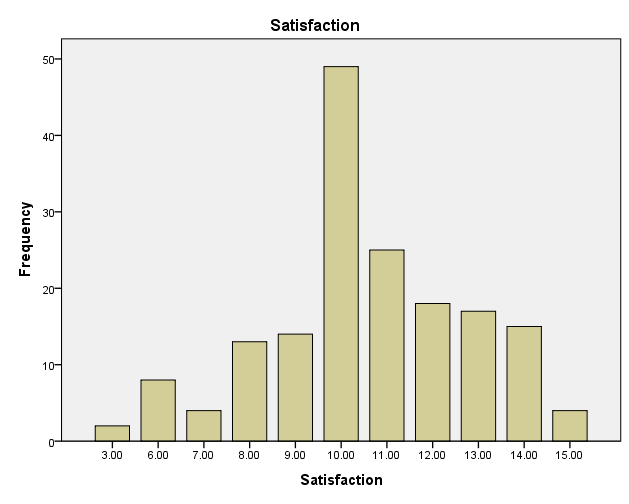
Table 4.13 summarized the frequency analysis for items measuring human resource management. According to the results, nearly half of the participants agree or strongly agree, “Proper deployment of human resources was beneficial in the preparation of Hong Kong Rugby Sevens 2014”. The aggregated mean value of logistical support is 3.52, suggesting that the sanitation and catering services are at a middle level. Figure 4.13 summarized the score of the items measuring human resource management.
Correlation analysis
Correlation between personnel manpower rearrangement and human resource management
There was a scatter plot in order to test the correlation between Personnel manpower rearrangement and human resource management. This was to ensure that there was not a violation of the assumptions of normality, linearity and homoscedasticity among the data. As seen in Figure 14 below, there is a strong, positive correlation between the variables of Personnel manpower rearrangement and human resource management and the data is normally distributed.
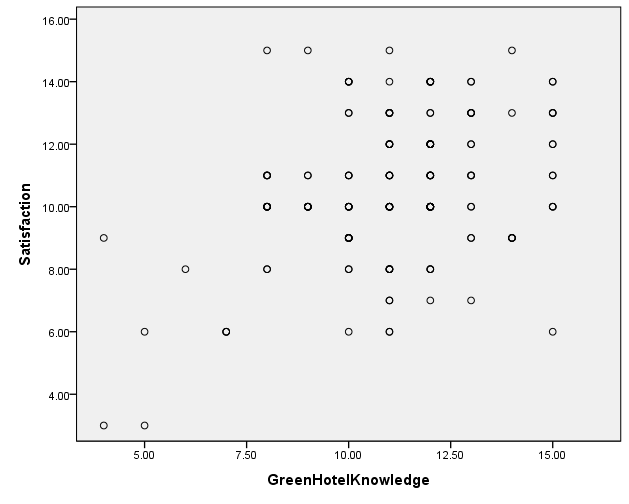
There was a Pearson product-moment correlation coefficient to analyse the relationship between Personnel manpower rearrangement and customer human resource management. This was after inspecting a positive correlation between Personnel manpower rearrangement and human resource management. The results are in table 4.14 above. The correlation value below 0.3 indicates low-level correlation; the correlation value between 0.3 and 0.6 indicates medium level correlation, while the correlation value above 0.6 indicates higher-level correlation. As can be seen in Table 4.14, there was a medium correlation between Personnel manpower rearrangement and human resource management, with a correlation value of 0.373, which is significant at 0.01 levels, indicating that higher levels of Personnel manpower rearrangement is associated with higher levels of customer human resource management.
Table 4.14: Correlation between personnel manpower and human resource management
The correlation between personnel deployment and human resource management
There was a scatter plot to check the correlation between Personnel manpower rearrangement and human resource management. As seen in Figure 4.15 below, there is a strong, positive correlation between the variables of personnel deployment and human resource management and the data is normally distributed.
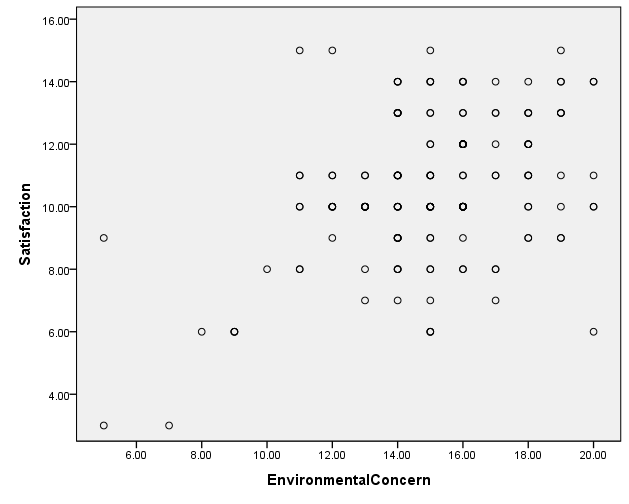
There was a Pearson product-moment correlation coefficient to analyse the relationship between personnel deployment and customer human resource management. This was after inspecting a positive correlation between personnel deployment and human resource management; the results are in table 15 below. As is in Table 15, there was a medium positive correlation between personnel deployment and human resource management. The correlation value was 0.313, which is significant at 0.01 level, indicating that a higher level of personnel deployment is associated with higher levels of customer human resource management.
Table 4.15: The correlation between personnel deployment and human resource management
The correlation between logistical support and human resource management
There was a scatter plot to check the correlation between a fair wage and human resource management. As seen in Figure 16 below, there is a strong, positive correlation between the variables of logistical support and human resource management and the data are normally distributed.
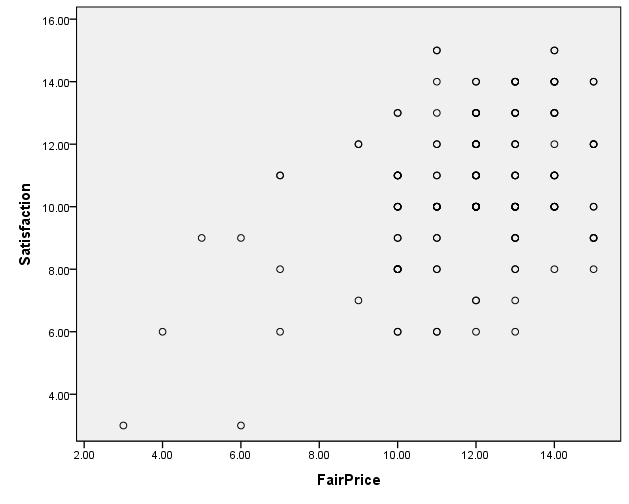
There was a Pearson product-moment correlation coefficient to analyse the relationship between logistical support and customer human resource management. This was after inspecting a positive correlation between a fair wage and human resource management. The results are shown in table 16 below. As can be seen from this table, there was a medium positive correlation between logistical support and human resource management, with a correlation value of 0.412, which is significant at 0.01 level, indicating that higher levels of logistical support is associated with higher levels of customer human resource management.
Table 4.16: Correlation between logistical support and human resource management
The correlation between Manpower rearrangement and Human resource management
In order to check the correlation between manpower rearrangement and human resource management, there was a scatter plot. As seen in Figure 4.17 below, there is a strong, positive correlation between the variables of manpower rearrangement and human resource management and the data is normally distributed.
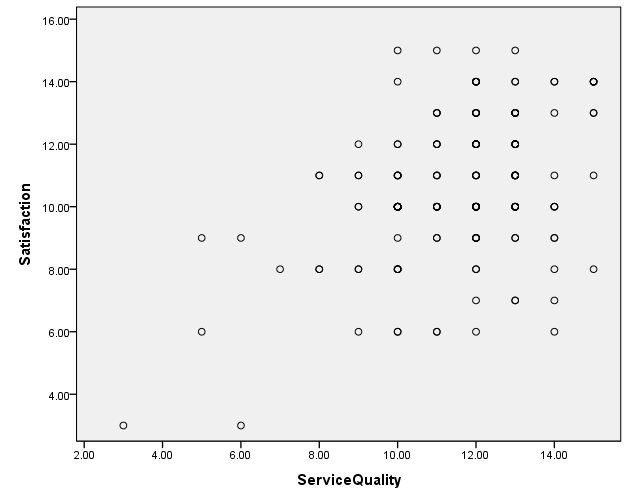
After inspecting a positive correlation between manpower rearrangement and human resource management, there was a Pearson product-moment correlation coefficient to analyse the relationship between manpower rearrangement and customer human resource management. The results are in Table 4.17 below. As can be seen from this table, there was a medium positive correlation between manpower rearrangement and human resource management, with a correlation value of 0.409, which is significant at 0.01 level, indicating that higher levels of manpower rearrangement is associated with higher levels of customer human resource management.
Table 4.17: Correlation between manpower rearrangement and human resource management
Correlation between Security check and Human resource management
In order to check the correlation between security check and human resource management, there was a scatter plot. As seen in Figure 4.18 below, there is a strong, positive correlation between the variables of security check and human resource management and the data is normally distributed.
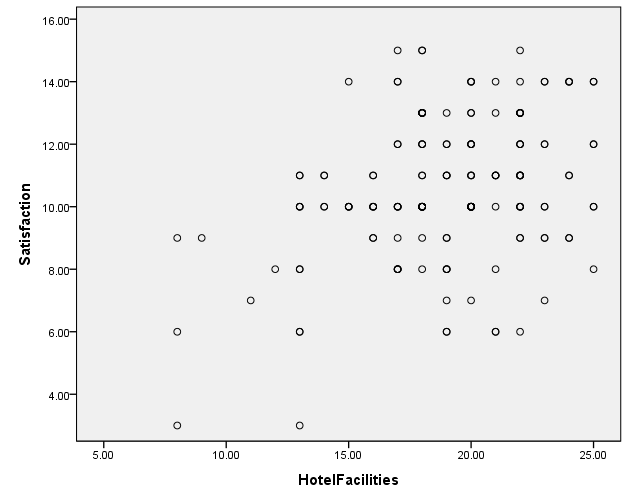
After inspecting a positive correlation between security check and human resource management, a Pearson product-moment correlation coefficient was carried out to analyse the relationship between security check and human resource management. The results are in Table 4.18 below. As can be seen from this table, there was a medium positive correlation between security check and human resource management, with a correlation value of 0.455, which is significant at 0.01level, indicating that higher levels of the security check is associated with human resource management.
Table 18: Correlation between security check and human resource management
The correlation between Sanitation and catering services and Human resource management
In order to check the correlation between sanitation and catering services and human resource management, there was a scatter plot. As seen in Figure 4.19 below, there is a strong, positive correlation between the variables of sanitation and catering services and human resource management and the data is normally distributed.
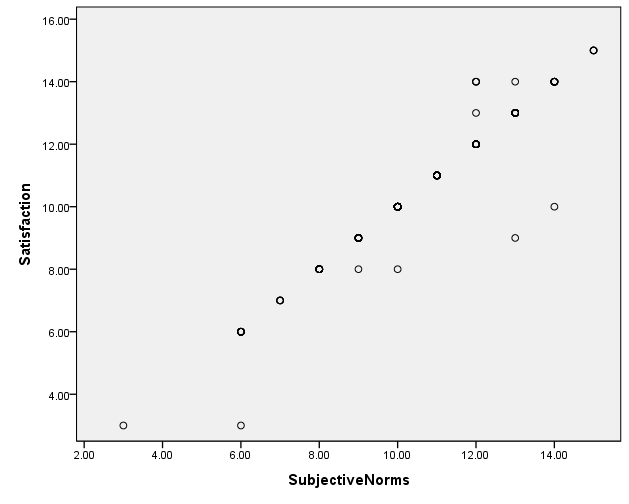
After inspecting a positive correlation between sanitation and catering services and human resource management, there was a Pearson product-moment correlation coefficient was to analyse the relationship between sanitation and catering services and customer human resource management. The results are in table 19 below. As can be seen from this table, there was a strong positive correlation between sanitation and catering services and human resource management, with a correlation value of 0.765, which is significant at 0.01 level, indicating that higher levels of sanitation and catering services is associated with successful human resource management.
Table 4.19: Correlation between Sanitation and catering services and Human resource management
Regression analysis
Regression analysis is a statistical process for estimating the relationships among variables (Blanchard and Cathy 68). More specifically, regression analysis helps to understand how the change of independent variables can affect the change of dependent variables (Blanchard and Cathy 69). The correlation analysis above indicated that there are relationships between sanitation and catering services, security check, Personnel manpower rearrangement, logistical support, manpower rearrangement, personnel deployment and human resource management. In order to find out how these variables influence customer human resource management and which one has the biggest impact, the multiple-linear regression is used.
Table 4.20: Model Summary
The Adjusted R Square is 0.536, which means that the independent variables of sanitation and catering services, security check, Personnel manpower rearrangement, logistical support, manpower rearrangement, and personnel deployment can explain 53.6% of the variance of human resource management.
Table 4.21: ANOVA
By summarizing the ANOVA table, it can be said that the independent variables of sanitation and catering services, security check, Personnel manpower rearrangement, logistical support, manpower rearrangement, and personnel deployment can predict the dependent variable of human resource management at a significance of 0.01, by considering F=411.961.
Table 4.22: Coefficients
The regression results are in Table 4.22 above. According to the results, there is no Collinearity problem among the independent variables as the VIF values for all independent variables are less than 10 and the Tolerance value for all variables are above 0.1.
Conclusions and Recommendations
Introduction
This chapter presents the conclusion and the recommendations of the findings and of the results in accordance with the objectives of this study.
Conclusion and recommendations
The organisation’s culture greatly impacts the way in which the HR management is carried out. Individuals who are highly talented greatly prefer to work in organizations with cultures that correspond to their individual capacity. When an organization wants to choose the suitable approach to manage its human resources, it should have in mind the leadership style that it anticipates to adopt in future, thus, HR management should be in line with its vision. The process of managing personnel will define what kind of a leader is in the making. Therefore, the HR management approach should be in line with the kind of leader that the organisation is expected to have in future.
With the recent ongoing global trend whereby organisations are applying total quality management approaches like laying down incompetent employees, the need for young and fresh talents has arisen. The HR management enables the organization to build a reserve army that is expected to take over after the older generation have been wiped out. Organizations have also done away with job security and retention of the employees is entirely based on competence and merit. Hardworking employees are highly rewarded to motivate them to remain in the organisation and also to enhance their level of loyalty.
Currently, the labour market is experiencing scarcity of qualified personnel. Therefore, organizations will have to strive to hold on to their key talents because finding a replacement is not easy. Another challenge is how to utilize the available resources to achieve optimal results that can satisfy all the stakeholders. Hede states that, by capitalizing on HR and incorporating it into the organization’s strategy, as posited by theories of Human Resource Management, organizations can gain competitive advantage, as well as satisfy its employees. There are some studies that points out a link between HR process and a number of aspects in major sporting events. However, these studies are still not able to identify the hidden HRM content that is significant when examining HR’s impact on the organization’s invisible assets.
Owing to the present focus on intangible assets more than ever before, the platforms at the present cater for organizations that can reap the potential of their principal resources. Attracting, locating and identifying key individuals that exemplify the core competence of the organization, regularly achieving beyond expectation while at the same time acting as a motivational factor to their fellow workers, is critical in the success of any event. This has been proven by the results of our study. From the findings, it is clear that HRM practices have a significant impact on personnel training, personnel deployment, logistical support, manpower rearrangement, security check, sanitation and catering services.
From the study, the independent variables of sanitation and catering services, security check, Personnel manpower rearrangement, logistical support, manpower rearrangement, and personnel deployment can predict the dependent variable of human resource management at a significance of 0.01, by considering F=411.96. It was also found that sanitation and catering services, security check, Personnel manpower rearrangement, logistical support, manpower rearrangement, and personnel deployment can significantly impact human resource management, with sig values all less than 0.05. Specifically, sanitation and catering services have the biggest impact on human resource management, with a standardized coefficient value of 0.437, followed by the security check, with a standardized coefficient value of 0.424 and logistical support, with a value of 0.334. The personnel deployment has the smallest impact on human resource management, with a standardized coefficient value of 0.212.However, sanitation and catering services have the biggest impact on human resource management, with a standardized coefficient value of 0.437, followed by the security check, with a standardized coefficient value of 0.424 and logistical support, with a value of 0.334. Event organizers are advised to allow a favourable atmosphere to exist in the working area. They should be of sound mind and should make their decisions without fear or favour. Both majorities and minorities should be given a chance to exercise their talents rather than being prejudiced or undermined. Failure to fulfil the desires of the employees will result to a massive exodus from the organization or unsuccessful event.
Works Cited
Al-Ababneh, Mukhles. “Leadership Style of Managers in Five-Star Hotels and Its Relationship with Employee’s Job Satisfaction.” IJMBS 3. 2 (2003):93.97. Print.
Backhous, Kristin and Surinder Tikoo. “Conceptualizing and researching employer branding.” Career Development International 9.5 (2004):501-517. Print.
Berger, Lance and Dorothy Berger. The Talent Management Handbook: Creating Organisational Excellence by Identifying, Developing, and Promoting Your Best People, New York: McGraw-Hill, 2004. Print.
Blanchard, Ken and Cathy Truett. The Generosity Factor: Discover the Joy of Giving Your Time, Talent, and Treasure, Oxford: Oxford University Press, 2002. Print.
Burns, James. Leadership, New York: Harper & Row, 1978. Print.
Dessler, Gary. Human resource management, New Jersey: Prentice-Hall, Englewood Cliffs, 2008. Print.
Chamoun, Jackie, Manfred Habicht and Anna Bernauer. Event, Sport and Entertainment Management, Glion: Glion Institute of Management, 2013. Print.
Chelladurai, Packianathan. Human Resource Management in Sport and Recreation, Champaign, IL: Human Kinetics, 2006. Print.
Hanlon, Clare and Bob Stewart. “Managing Personnel in Major Sport Event Organisations: What Strategies Are Required?” Event Management 10.1 (2006): 77-88. Print.
Glannoulakis, Constantinos, Chou Wang and David Gray. “Measuring volunteer motivation in mega-sporting events.” Event Management 11 (2008): 191-200. Print.
Lawler, Edward and Susan Mohrman. “HR as a strategic partner: What does it take to make it happen?” Human Resource Planning 26.3 (2003):15-29. Print.
Lovell, Ken. Strategic Human Resource Management: What does it mean in practice? Lismore: Southern Cross University, 2009. Print.
Phillips, Jack. Investing in Your Company’s Human Capital, New York: AMACOM, 2005.Print.
Robinson, Leigh. Managing Olympic Sport Organizations, Lausanne, Switzerland: International Olympic Committee, 2007. Print.
Saunders, Mark, Thornhill Adrian and Phillip Lewis. Research Methods for Business Students, New York, NY: Prentice Hall, 2009. Print.
Signes, Emil. History of Hong Kong Sevens. 2015. Web.
Scott, Susan. “Research Methodology: Sampling Techniques.” Journal of Scientific Research 2.1 (2011): 87-92. Print.
Sokun, Nhek. Human Resource Management of Price Waterhouse Coopers, Phnom Penh, Cambodia: National University of Management, 2004.Print.
Tasmia. Event Management: Sports and Recreation, Melbourne: Tasmia, Inc., 2014. Print.
York, Kenneth. Applied Resource Management: Strategic Issues and Experiential Exercise, New York: Sage Publications, 2009.Print.
Zhao, Jinlin. Managing Strategies at Beijing Olympic Catering Services Project, Miami, Florida: Florida International University, 2009. Print.
